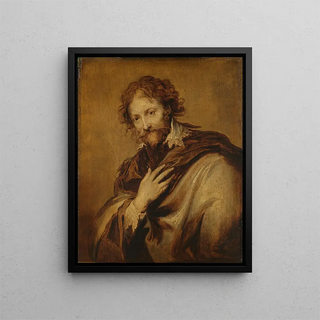Art print | Portrait of Pierre Paul Rubens 1577-1640 - School of Antoine van Dyck


View from behind

Frame (optional)
Reproduction Portrait of Pierre Paul Rubens 1577-1640 - School of Antoine van Dyck – Captivating Introduction
The "Portrait of Pierre Paul Rubens 1577-1640" created by the School of Antoine van Dyck is an iconic work that transcends the simple frame of painting to become a true window into the soul of one of the greatest masters of Baroque art. This portrait, which captures not only Rubens' physical features but also his charisma and stature, invites the viewer to immerse themselves in a universe where art and personality meet with rare intensity. The work bears witness to an era when painting was a means of asserting social status and place in history, while also revealing the complexity of the depicted individual. Through this portrait, van Dyck's technical mastery combines with emotional sensitivity, making this piece a timeless masterpiece.
Style and uniqueness of the work
The style of this portrait is distinguished by its rich chromatic palette and dramatic lighting, characteristic of the Baroque. Van Dyck, a pupil of Rubens, mastered the techniques of his master while developing a personal style that is uniquely his own. In this work, the nuances of light and shadow create an almost theatrical atmosphere, emphasizing Rubens' facial features while revealing the texture of the luxurious fabrics he wears. The meticulous details, such as embroidery and fabric reflections, demonstrate a concern for realism that was revolutionary at the time. This portrait does not merely depict a man; it tells a story, that of an artist at the height of his craft, while evoking themes of glory and immortality that run through Rubens' own work.
The artist and his influence
Antoine van Dyck, born in 1599, established himself as one of the most influential portraitists of his time. A pupil of Rubens, he inherited a refined technique and an innovative approach to human representation. By painting his master's portrait, van Dyck not only pays homage to Rubens; he also incorporates his own style into the Flemish tradition. The impact of van Dyck

Matte finish

View from behind

Frame (optional)
Reproduction Portrait of Pierre Paul Rubens 1577-1640 - School of Antoine van Dyck – Captivating Introduction
The "Portrait of Pierre Paul Rubens 1577-1640" created by the School of Antoine van Dyck is an iconic work that transcends the simple frame of painting to become a true window into the soul of one of the greatest masters of Baroque art. This portrait, which captures not only Rubens' physical features but also his charisma and stature, invites the viewer to immerse themselves in a universe where art and personality meet with rare intensity. The work bears witness to an era when painting was a means of asserting social status and place in history, while also revealing the complexity of the depicted individual. Through this portrait, van Dyck's technical mastery combines with emotional sensitivity, making this piece a timeless masterpiece.
Style and uniqueness of the work
The style of this portrait is distinguished by its rich chromatic palette and dramatic lighting, characteristic of the Baroque. Van Dyck, a pupil of Rubens, mastered the techniques of his master while developing a personal style that is uniquely his own. In this work, the nuances of light and shadow create an almost theatrical atmosphere, emphasizing Rubens' facial features while revealing the texture of the luxurious fabrics he wears. The meticulous details, such as embroidery and fabric reflections, demonstrate a concern for realism that was revolutionary at the time. This portrait does not merely depict a man; it tells a story, that of an artist at the height of his craft, while evoking themes of glory and immortality that run through Rubens' own work.
The artist and his influence
Antoine van Dyck, born in 1599, established himself as one of the most influential portraitists of his time. A pupil of Rubens, he inherited a refined technique and an innovative approach to human representation. By painting his master's portrait, van Dyck not only pays homage to Rubens; he also incorporates his own style into the Flemish tradition. The impact of van Dyck






